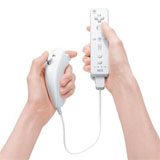Use your intuition
Nintendo is aiming to win over a fresh generation of players with its new, more user-friendly consoles and controllers. Alex Wiltshire speaks to Toshio Iwai, designer of one of the new breed of computer games

Nintendo is aiming to win over a fresh generation of players with its new, more user-friendly consoles and controllers. Alex Wiltshire speaks to Toshio Iwai, designer of one of the new breed of computer games
AMID the cacophony of a thousand digitised explosions, gunshots and growling engines at this year’s E3 video games expo in Los Angeles, a quiet revolution was taking place. The biggest queues weren’t to see Sony’s newly unveiled PlayStation 3, nor were they to see Microsoft’s high-octane shooting games. They were to see Nintendo’s Wii console (pictured above) – the latest manifestation of its new ‘New Ways to Play’ design strategy.
The queues were for the Wii’s controller, which looks like a TV remote and can sense movement and its position in space. With cutting-edge interface and product design like this, Nintendo hopes to attract new generations of people to buy its games and hardware – people left cold by the dazzling, but conventional pyrotechnics of the Xbox 360 and the PlayStation 3.
‘As we spend more time and money chasing exactly the same players, who are we leaving behind?’ That was the question posed by Nintendo’s president, Satoru Iwata, at the Game Developers Conference last year. It’s a shrewd idea. Video game sales in Japan are slowly declining, due in part to Japan’s aging population, and costs of developing games for the increasing complexity and power of the latest consoles are spiralling.
Nintendo’s first salvo in its campaign was its successful DS handheld console, which it released last year. It features a touch- sensitive screen that allows players to control games through drawing. Highly adaptable, the screen can act like a computer mouse pointer for strategy games. It is fast and accurate for shooting games and allows drawing and writing too.
Next month, the DS sees the release of Electroplankton. Designed by media artist Toshio Iwai, it’s not really a game, but it epitomises the breadth of the types of software Nintendo hopes its hardware can inspire. It acts as a kind of musical instrument, with the player manipulating electroplankton – small sound-making creatures – with the touch screen.
In one scenario, tapping an electroplankton makes it chime in a tone dependent on its position and send a shockwave out. If the shockwave hits other electroplankton, they also chime and send out their own shockwaves, creating chains of sounds defined by the way the player has placed them on the screen. In another, electroplankton follow lines that the player draws on the screen and make sounds dependent on their position, length and direction.
This is the fourth ‘game’ Iwai has worked on. He was attracted to video games because they were interactive and wanted to make something in which players could be creative. ‘I came to an idea to create something like an instrument, which can manipulate images and music simultaneously, by using the functions of a video game machine,’ he explains.

Electroplankton is all about inspiring people to play instinctively, immediately rewarding interaction with a shower of noise. ‘Everybody wants to touch instruments or toys they haven’t seen before,’ says Iwai. ‘When I design something, I am trying to create it so that it is very attractive at first sight. If players touch it, it can be understood instinctively and the players can be pulled into it very strongly and start trying to create their own designs in many different ways.’
Such principles are central to both the DS’s touch screen interface and the Wii controller. The Wii’s controller is designed to look and feel familiar to people who are confused by the abstract buttons and joysticks of a traditional joypad. ‘We started out with a very simple question,’ explained Iwata earlier this year. ‘Why is it that anyone feels comfortable picking up a remote control for a TV, but many people are afraid to even touch the controller for a video game system? This was our starting point.’
In a tennis game Nintendo demonstrated, players make shots by swinging the remote like they might a racquet. In the shooter game Metroid, the controller is used to aim at targets, like a gun. The hope is that by embodying in-game actions, these games are more natural to play – and therefore more attractive to people who wouldn’t normally play games. If the success of the DS is anything to go by, the idea is working.
By looking towards interface and product design to inform its new hardware, rather than processing power, Nintendo has brought some of the freshest ideas to video games culture for many years. It might be one of the most venerable video games companies, but Nintendo is proving that age isn’t a barrier to creativity.
-
Post a comment




